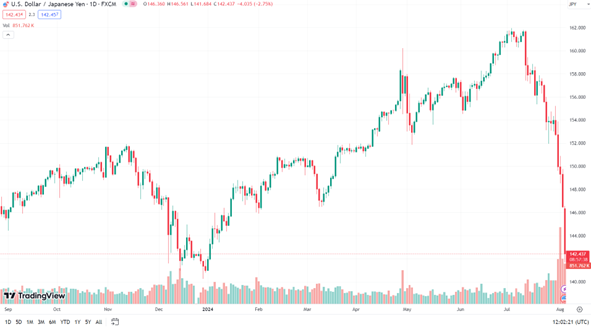It turns out the dam broke overnight in Japan – and the resulting flood of selling has washed over global markets. I covered all the trading action in detail here, and I encourage you to check that article out.
Now, let’s focus on what’s helping fuel the selloff: The yen carry trade I first warned about in April. To kick things off, take a look at this week’s MoneyShow Chart of the Week: The USDJPY currency pair going back one year.
USDJPY Chart (1-Year)

Source: TradingView
If you recall, I wrote in April that: “Many global investors are involved in so-called carry trades – borrowing in yen at rock-bottom rates, selling the currency, and buying assets in other markets and currencies where yields are higher.”
Then I said that IF the Bank of Japan’s efforts to stem the fall in the yen proved successful, “it could lead to carry trades unwinding. Result? Mass dumping of assets like stocks and bonds.”
What has happened since then? The BOJ’s most recent intervention in July occurred right as we got cooler-than-expected CPI inflation data here in the US. That caused the yen to start reversing course against the dollar. Then the BOJ actually HIKED rates by 25 basis points last Wednesday, bucking the global trend of central banks CUTTING them.
That poured gasoline on an already-raging fire, sending the yen through the roof. That, in turn, helped trigger carry trade unwinding on a massive scale. The Nikkei 225 Index plunged more than 12% overnight, the worst decline in that country since the “Black Monday” stock market crash in 1987.
What comes next? Again, my earlier article goes into much more detail. But when it comes to the yen, we’re testing an important zone of support around 140-142 that dates back to year-end 2023. If that gives way, the next big level I see is around 137.
If you’re long stocks, you want to see these support areas hold. You also want the Federal Reserve to admit it might have made a mistake by not cutting rates recently, and possibly initiate a 25-basis-point “emergency” cut. And you want the BOJ to come out and say it doesn’t like excess yen volatility and that it is closely monitoring the situation (code for “We realize we screwed up, too. We are admitting it. You can stop overreacting.”)
Based on what I’ve seen in similar crises like this in the past, that’s roughly what I’m expecting to see now. And it’s the kind of thing that would allow the floodwaters to recede, and calm to return to markets. We shall see.










